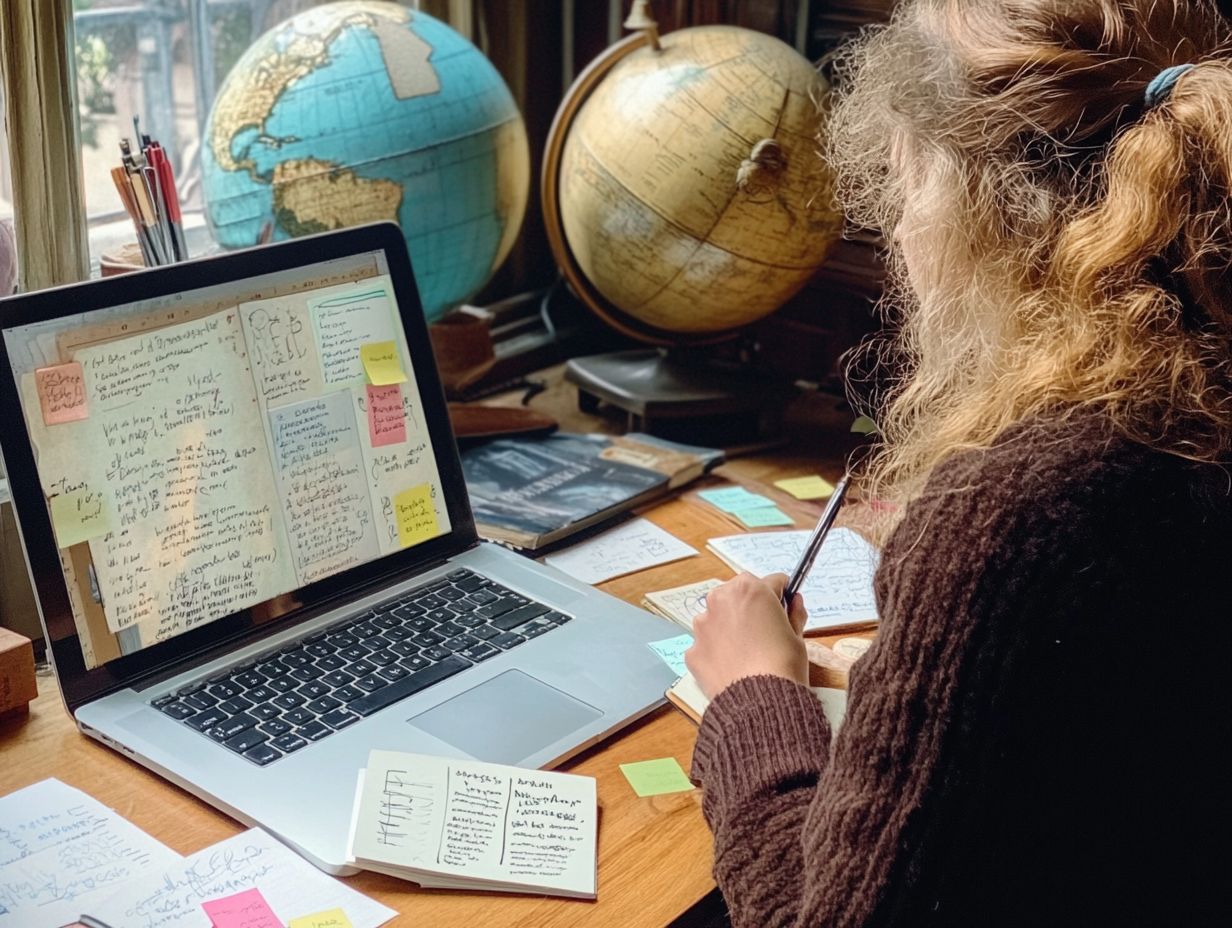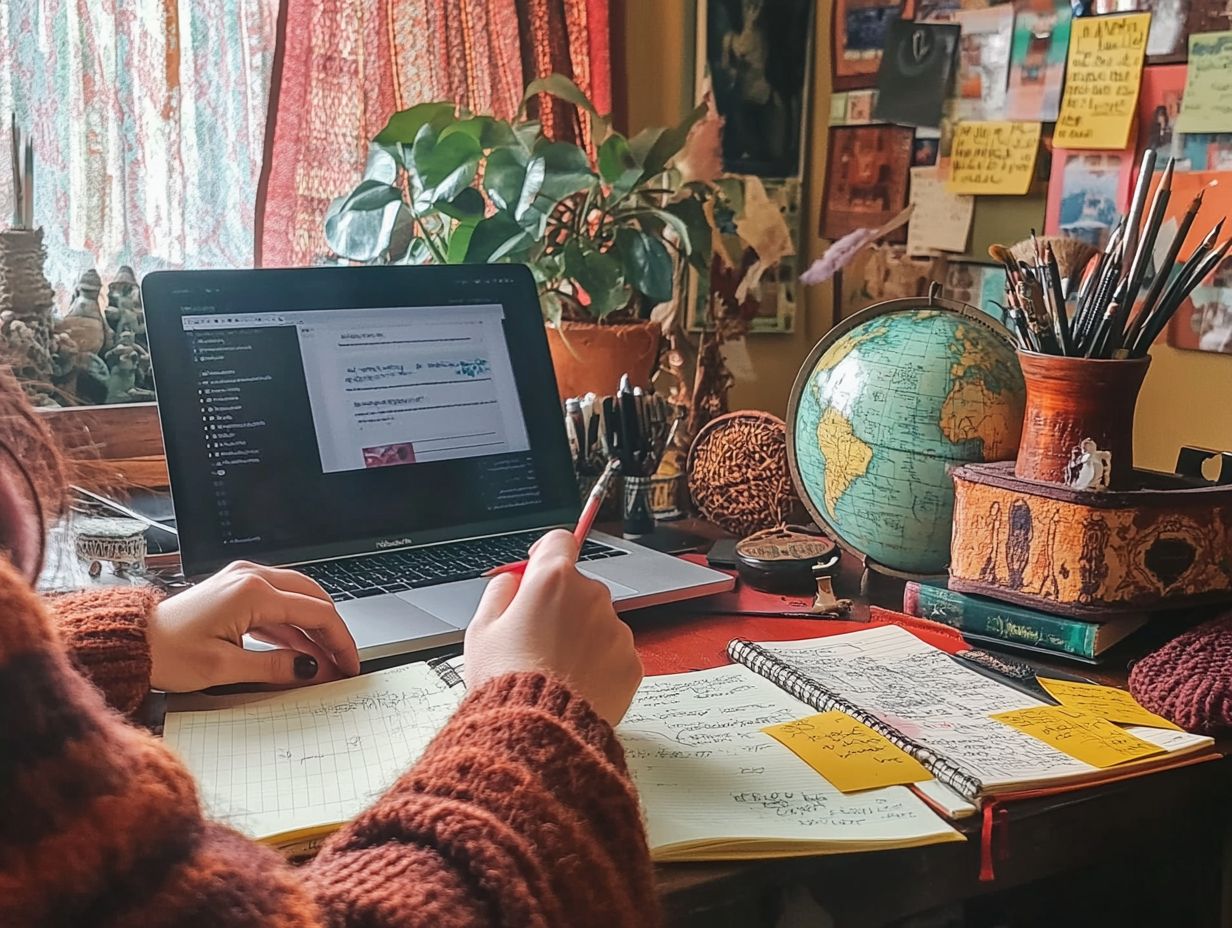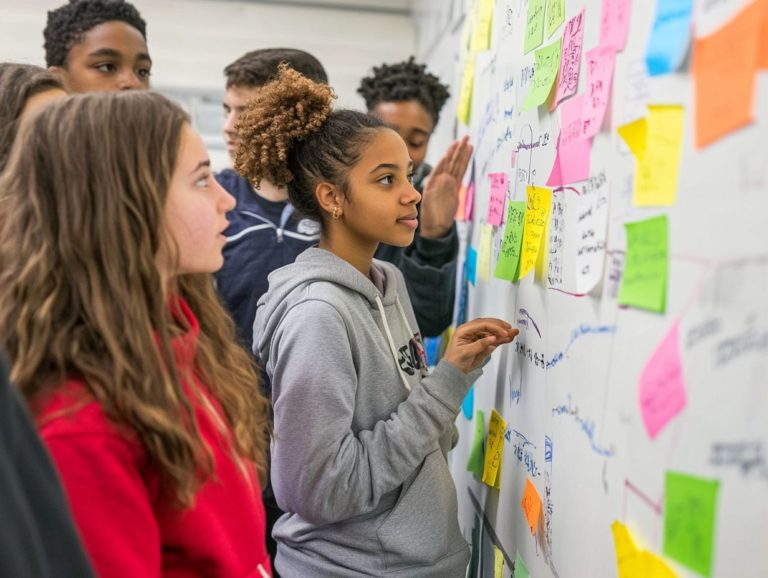How to Document Your Cultural Adjustment Journey
Cultural adjustment is a journey brimming with unique experiences, challenges, and opportunities for personal growth. Understanding this process can significantly enhance your transition into a new environment, transforming it into a more enriching endeavor.
As you document your journey, you’ll find it allows for deeper reflection on your experiences and provides valuable insights for others traveling similar paths.
This article delves into the definition of cultural adjustment, the benefits of capturing your experiences, practical tips on how to document them effectively, and strategies for sharing your story with impact.
Get ready for an exciting journey of cultural adaptation!
Contents
- Key Takeaways:
- Understanding Cultural Adjustment
- Why Document Your Cultural Adjustment Journey?
- How to Document Your Journey
- Sharing Your Journey
- Challenges and Solutions
- Frequently Asked Questions
- What is cultural adjustment?
- Why is it important to document your cultural adjustment journey?
- What are some ways to document your cultural adjustment journey?
- How can documenting your cultural adjustment journey help others?
- What are some tips for effectively documenting your cultural adjustment journey?
- Can I document my cultural adjustment journey anonymously?
Key Takeaways:
- Reflect on your cultural adjustment journey by documenting it through a medium of your choice.
- Documenting helps you track your progress and share your story.
- Make your journey meaningful by sharing it and seeking support.
Understanding Cultural Adjustment
Cultural adjustment is an essential journey that you, especially as an international student, will embark on when transitioning to a new environment, such as studying in a different country.
This adaptation often kicks off with culture shock, which refers to the confusion and discomfort you feel when you encounter new customs and ways of life. It is a blend of emotional and psychological challenges that arise as you encounter unfamiliar customs and cultural practices.
As you navigate these complexities, you may find yourself moving through various stages of adapting. Each stage plays a crucial role in shaping your emotional well-being and personal growth.
Definition and Process
Cultural adjustment is the process through which you learn to adapt to new cultural environments after experiencing that jarring culture shock. This journey goes beyond simply overcoming initial discomfort; it involves a fundamental transformation in how you perceive the world, behave within it, and manage your emotional state.
Understanding cultural adjustment is vital, as it can significantly influence your social interactions, work dynamics, and overall mental well-being. This adaptation process typically unfolds in several stages. It starts with the honeymoon phase, where excitement reigns supreme, followed by a stage of frustration, as the differences between cultures become more pronounced.
Eventually, you may reach a stage of gradual acceptance, allowing you to navigate your new surroundings with greater ease. It’s important to recognize that cultural adjustment can also lead to mental health issues, such as anxiety and depression, especially if you struggle to find belonging or feel isolated in your new culture.
Why Document Your Cultural Adjustment Journey?
Documenting your cultural adjustment journey is essential for fostering personal growth and enhancing your emotional well-being. This process enables you to reflect on your experiences and the coping strategies you employ as you adapt to a new culture. For tips on this important process, check out how to document your travels as a student.
By capturing these moments, you not only gain insight into your own evolution but also create a valuable resource for navigating future challenges.
Benefits of Documenting
Documenting your cultural adjustment journey offers a wealth of benefits, including enhanced personal growth, improved emotional support, and the development of effective coping strategies.
By regularly reflecting on your experiences through journaling or other forms of documentation, you can gain deeper insights into your feelings and reactions. This is especially valuable as you navigate the complexities of new cultural landscapes. This reflective practice helps you recognize and appreciate cultural differences and fosters empathy toward others perspectives.
When you share these documented experiences, you can receive emotional support from peers who are undergoing similar transitions, creating a sense of community and understanding. Ultimately, this process encourages resilience and adaptability essential qualities for thriving in a multicultural environment.
How to Document Your Journey

You can document your cultural adjustment journey through various methods, with reflective journaling as a powerful way to explore your daily habits and assess your emotional readiness as you adapt to a new culture.
Choosing a Medium
When it comes to choosing a medium for documenting your journey, you have a few great options: reflective journaling, digital blogs, or video diaries.
Each of these offers distinct benefits that can enhance your emotional support experience. Reflective journaling helps you think deeply about your feelings and experiences in a private space. This method helps you become more self-aware, though it may not provide the external feedback that some might seek.
Digital blogs allow you to share your thoughts and challenges with a broader audience. This can lead to supportive comments and advice, but be ready for the reality that your personal struggles might be laid bare for public scrutiny.
Video diaries bring your emotions to life through visual and auditory elements, making your feelings more tangible. However, this approach requires some basic editing skills, like trimming and adding clips, and a comfort level with being on camera.
Ultimately, each of these mediums can act as a bridge, helping you gain a deeper understanding of your emotions as you navigate the intricate landscape of cultural adjustment.
What to Include
When documenting your cultural adjustment journey, capture the essence of your daily habits, emotional experiences, and thoughtful reflections on the cultural practices you encounter.
This could range from your cherished morning rituals like savoring a quiet cup of tea or engaging in yoga to those introspective moments where you process the emotional highs and lows of this transition.
Watching local customs, such as vibrant community festivals, dining etiquette, or unique holiday celebrations, adds a lot to your experience. Reflect on how these practices impact your feelings and thoughts.
Consider the contrasts with your own cultural background. Documenting your interactions with locals can reveal valuable learning moments, deepening your understanding and appreciation of the culture you re immersing yourself in.
Sharing Your Journey
Sharing your cultural adjustment journey with others can offer invaluable social support and cultivate a sense of community.
This exchange of personal experiences and cultural insights enriches your own understanding and deepens connections with those around you.
Benefits of Sharing
Sharing your journey brings a wealth of benefits, including improved emotional well-being, expanded social support, and the chance to gain invaluable cultural insights.
When you open up about your experiences, you often discover a strong sense of belonging that helps combat feelings of isolation and bolsters your emotional resilience.
These shared narratives can bridge cultural divides, allowing learning about various customs, traditions, and perspectives. This exchange broadens your horizons and fosters empathy, helping you appreciate the intricate tapestry of human experiences.
Ultimately, sharing these journeys cultivates a supportive network that nurtures your growth, encourages adaptive strategies, and enhances your overall life satisfaction.
Tips for Sharing

Ready to share your amazing cultural adjustment journey? Let s dive in! To truly share your experiences, consider using social media platforms and community groups. This approach can broaden the reach of your experiences and foster meaningful connections.
Engaging with platforms like Instagram, Facebook, and Twitter allows you to document your story visually and textually. This helps craft a narrative that resonates with a wider audience.
Additionally, joining local meetups or forums focused on cultural exchange provides a supportive backdrop. Here, shared experiences can serve as valuable lessons and inspiration.
Utilizing relevant hashtags like #CulturalAdjustment or #Expats makes it easier for others navigating similar transitions to discover your insights. Don t forget the power of engagement! Actively responding to comments and encouraging discussions can deepen connections, transforming solitary experiences into a vibrant communal journey.
Challenges and Solutions
Encountering challenges during cultural adjustment is entirely natural. By recognizing these common obstacles, you can develop effective coping strategies to navigate both emotional and communication barriers more easily.
Common Challenges in Documenting and How to Overcome Them
Documenting your cultural adjustment journey presents its share of challenges, such as emotional readiness, time constraints, and the fear of vulnerability.
However, these obstacles can be navigated with effective coping strategies and a solid support system.
You might find yourself wrestling with the emotional landscape of your experiences, which can be overwhelming. Cultivating emotional readiness is vital, as it paves the way for genuine expression and meaningful reflection.
Time constraints can also be a significant barrier, especially if you’re juggling job responsibilities or personal commitments. To tackle this, consider carving out dedicated time for reflection whether through journaling or engaging in focused discussions with friends. This can provide immense clarity and insight.
The fear of vulnerability might hold you back from sharing your genuine thoughts and feelings. Embracing this vulnerability can actually deepen your connections with others. Seek support from groups made up of people from different cultures, as they can enrich your journey and offer a safe space to share experiences and receive encouragement.
Frequently Asked Questions
What is cultural adjustment?
Cultural adjustment refers to the process of adapting to a new culture and its norms, customs, and beliefs.
Why is it important to document your cultural adjustment journey?

Documenting your cultural adjustment journey allows you to reflect on your experiences, track your progress, and share your story with others.
What are some ways to document your cultural adjustment journey?
You can keep a journal, create a scrapbook, take photos and videos, write a blog, or use social media to document your journey.
How can documenting your cultural adjustment journey help others?
By sharing your experiences, challenges, and successes, you provide valuable insights and guidance to others going through a similar process.
What are some tips for effectively documenting your cultural adjustment journey?
Be honest and open about your experiences. Take time to reflect on your thoughts and feelings, and use different mediums to capture your journey.
Can I document my cultural adjustment journey anonymously?
Yes! If you prefer to keep your identity private, you can document your journey anonymously. Create a pseudonym or use a private blog or social media account to share your experiences.






